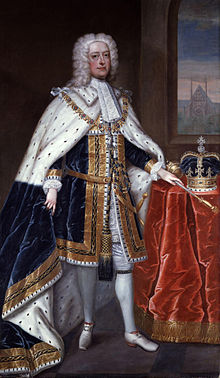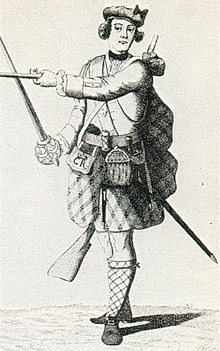Disarming Act
The Disarming Act ( English " Disarming Act ") refers to several English laws that were passed in the 18th century in response to the Jacobite uprisings in Scotland . The best known and most momentous of these laws was the Act of Proscription of 1746. Colloquially, this law is usually meant when the "Disarming Act" is spoken of. The Dress Act is a section of the Act of Proscription that makes wearing traditional highland clothing a criminal offense.
Disarming Act 1716

After the kingdoms of England and Scotland had been ruled by the House of Stuart in personal union from 1603 , the two kingdoms were united to form the Kingdom of Great Britain in the Act of Union in 1707 . When the House of Stuart was replaced by the House of Hanover ( George I ) in 1714, the following year saw the first uprising of the supporters of the House of Stuart (" The Fifteen "), to which the clans of the Scottish Highlands belonged.
On November 1, 1716, the first disarmament law was enacted with the title: "An act for the more effective securing the peace of the highlands in Scotland" .
The law in certain parts of Scotland prohibited the possession, use or carrying of weapons ( "... to have in his, her or their custody, use, or bear, broad sword or target, poignard, whinger, or durk, side pistol, gun, or other warlike weapon " ). The law was ineffective.
The explicitly named areas to which the following laws also applied included Dunbartonshire (now East and West Dunbartonshire ), Stirlingshire , Perthshire , Kincardineshire , Aberdeenshire , Inverness-shire , Nairnshire , Ross-shire and Cromartyshire (now Ross and Cromarty ), Argyll , Angus (Forfarshire), Banffshire , Sutherland , Caithness and Morayshire (Elginshire) ( “… within the shire of Dunbartain, on the north side of the water of Leven, Stirling on the north side of the river of Forth, Perth, Kincardin , Aberdeen, Inverness, Nairn, Cromarty, Argyle, Forfar, Bamff, Sutherland, Caithness, Elgine and Ross ... “ ). (See also Traditional Counties of Scotland .)
Disarming Act 1725
In 1725 a second law followed with the title “An act for the more effectual disarming the highlands in that part of Great Britain called Scotland; and for the better securing the peace and quiet of that part of the kingdom " .
This law was enforced with greater success by Major General George Wade . He succeeded in confiscating large quantities of weapons in the Highlands. The consequences were evident in the second and last Jacobite revolt in 1745 (" The Forty-Five "): In the battle of Prestonpans , the highlanders used a wide variety of out-of-date weapons. In the Battle of Culloden on April 16, 1746, the highlanders were better equipped with captured rifles, but the Jacobites were defeated here.
Act of Proscription 1746

After the victory at Culloden, a new disarmament law was passed on August 1, 1746:
“An act for the more effective disarming the highlands in Scotland; and for the more effective securing the peace of the said highlands; and for restraining the use of the highland dress; and for further indemnifying such persons as have acted in the defense of His Majesty's person and government, during the unnatural rebellion; and for indemnifying the judges and other officers of the court of judiciary in Scotland, for not performing the northern circuit in May, one thousand seven hundred and forty six; and for obliging the masters and teachers of private schools in Scotland, and chaplains, tutors and governors of children or youth, to take the oaths to his majesty, his heirs and successors, and to register the same. "
After the experiences with the first laws, this time the clan system of the Scottish Highlands was to be smashed as a whole in addition to a pure disarmament in order to prevent future uprisings. Measures for this were the restriction of traditional clothing ( "restraining the use of the highland dress" ) as well as the control of private schools and the swearing-in and registration of teachers and educators ( "obliging the masters and teachers of private schools in Scotland, and chaplains, tutors and governors of children or youth, to take the oaths to his majesty, his heirs and successors, and to register the same " ).
Dress Act
The Highland Clothing Prohibition, also known as the Dress Act , is a section of the Act of Proscription of 1746 that was initially due to come into effect on August 1, 1747:
"And be it further enacted by the authority aforesaid, That from and after the first day of August, one thousand seven hundred and forty seven, no man or boy, within that part of Great Briton called Scotland, other than shall be employed as officers and soldiers in his Majesty's forces, shall on any pretence whatsoever, wear or put on the clothes commonly called Highland Clothes (that is to say) the plaid, philibeg, or little kilt, trowse, shoulder belts, or any part whatsoever of what peculiarly belongs to the highland garb; and that no tartan, or partly-colored plaid or stuff shall be used for great coats, or for upper coats; and if any such person shall presume, after the said first day of August, to wear or put on the aforesaid garments or any part of them, every such person so offending, being convicted thereof by the oath of one or more credible witness or witnesses before any court of justiciary, or any one or more justices of the peace for the shire or stewartry, or judge ordinary of the place where such offense shall be committed, shall suffer imprisonment, without bail, during the space of six months, and no longer; and being convicted for a second offense before a court of justiciary or at the circuits, shall be liable to be transported to any of his Majesty's plantations beyond the seas, there to remain for a space of seven years. "
Wearing was banned plaid , kilt and Trews and the use of tartans for capes or jackets. The punishment was imprisonment for up to six months and, if repeated, deportation .
In a first amendment to the Act of Proscription, the period for the prohibition of highland clothing was extended to August 1, 1748. A second and final addition under the title “An Act to amend and enforce so much of an Act made in the nineteenth Year of his Majesty's Reign, as related to the more effectual disarming the Highlands in Scotland, and restrainig the Use of the Highland Dress “ Brought a further delay until December 25, 1748 and new exceptions. In particular, "landed men" , i.e. the land-owning upper class, were allowed to wear highland clothing and to own a limited number of weapons.
Officers and soldiers in the service of the English king were also expressly excluded. This initially affected the 42nd Highland Regiment, "The Black Watch" (now part of the Royal Regiment of Scotland ) , which was officially founded in 1739 . This regiment was made up of six companies that George Wade had set up from the highlands as early as 1725. These soldiers, like the other Highland regiments formed later, continued to wear kilts.
Myths
There are a number of myths associated with the Act of Proscription, some of which have also found their way into the specialist literature. A ban on playing the bagpipes , the Gaelic language or a ban on assembly is nowhere to be found in the law or the amendments.
The last section of the Act contains the only mention of languages: private schools teaching English, Latin or Greek had to be registered ( "... it shall not be lawful for any person in Scotland to keep a private school for teaching English, Latin, Greek, or any part of literature, ... until the situation and description of such private school be first entered and registered in a book ... " ). - Outside the universities and schools, Gaelic remained the colloquial language of the highlands.
In particular, the myth of the ban on the bagpipes became more and more entrenched from 1749 onwards. Seamus MacNeill, director of the College of Piping in Glasgow, wrote in 1975: “the situation for piping changed drastically. From 1746 to 1782 to play the bagpipe was a criminal offense punishable by death. "
The origin of this myth can be seen in the fact that after the 1745 uprising some pipers were actually indicted. One of them, James Reid, was executed in York on November 15, 1746. At that time the Dress Act was not yet in force. James Reid was one of the Jacobites who occupied Carlisle in December 1745 . He was charged and convicted of participating in a rebellion and high treason, not of playing the bagpipes. Reid defended himself by stating that he was not a combatant , just Piper. The judge replied that no regiment ever marched without music and that the bagpipes should therefore be regarded as a weapon of war:
“No regiment ever marched without musical instruments such as drums, trumpets and the like; and that a highland regiment never marched without a piper; and therefore his bagpipe, in the eye of the law, what an instrument of war. "
That sentence would twist the history of pipe music for generations. Among the hundreds of insurgents charged after 1745, only five were Piper in total, one of whom was executed, one exiled and two acquitted. The fate of the fifth is not known. For the period between 1748 and 1782, no evidence has been found in court records that a piper was ever charged with bagpipes. Looking at the lists of insurgents captured, the Fiddlers suffered more than the Piper: three of them were banished.
Apart from one spectacular individual case, the bagpipes were not affected during this time - at least not by English law.
Repeal of the Dress Act 1782
On July 1, 1782, a law on the "Use of Highland Dress Act" was passed, which officially repealed the Dress Act. The repeal was made public through the following proclamation in English and Gaelic:
"Listen Men. This is bringing before all the Sons of the Gael, the King and Parliament of Britain have forever abolished the act against the Highland Dress;" which came down to the Clans from the beginning of the world to the year 1746. This must bring great joy to every Highland Heart. You are no longer bound down to the unmanly dress of the Lowlander. This is declaring to every man, young and old, simple and gentle, that they may after this put on and wear the Truis, the Little Kilt, the Coat, and the Striped Hose, as also the Belted Plaid, without fear of the Law of the realm or the spite of the enemies. "
Individual evidence
- ↑ United Kingdom, Statutes , 19 Geo. 2, cap. 39, 1746, 587-602
- ↑ United Kingdom, Statutes , 21 Geo. 2, cap. 34, 1748
- ^ A b c John G. Gibson: Traditional Gaelic Bagpiping 1745-1945. 1998. ISBN 0-7735-1541-0
- ^ Donald MacDonald: Collection of the Ancient Martial Music of Caledonia. 1975, p. V
- ↑ quoted in: Seton and Arnot: Prisoners of the '45 , pp. 166f
- ↑ United Kingdom, Statutes , 22 Geo. 3, cap. 63, 1782

